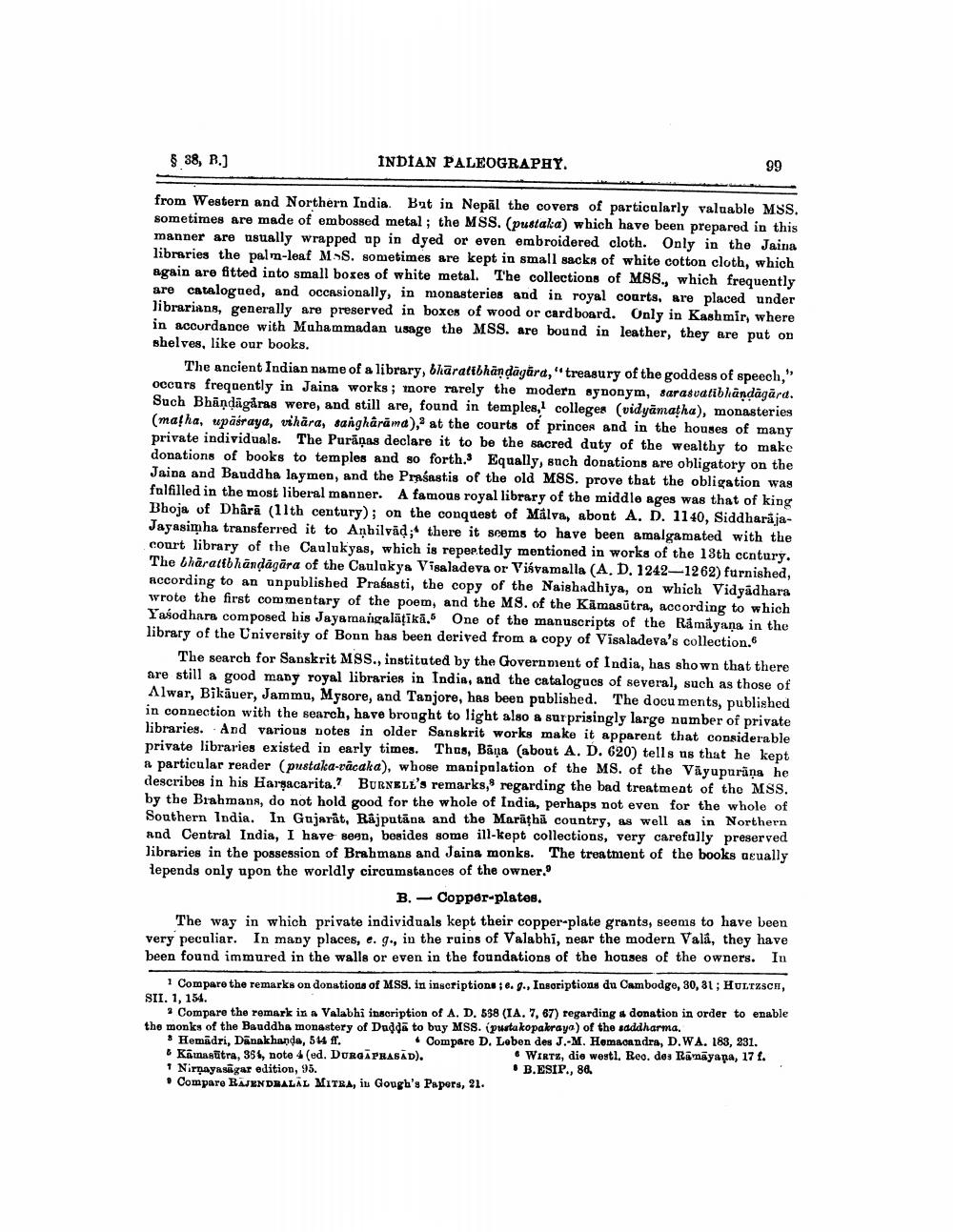________________
$ 38, R.]
INDIAN PALEOGRAPHY.
99
from Western and Northern India. But in Nepal the covers of particularly valuable MSS. sometimes are made of embossed metal; the MSS. (pustaka) which have been prepared in this manner are usually wrapped up in dyed or even embroidered cloth. Only in the Jaina libraries the palm-leaf MSS. sometimes are kept in small sacks of white cotton cloth, which again are fitted into small boxes of white metal. The collections of MSS., which frequently are catalogued, and occasionally, in monasteries and in royal courts, are placed under librarians, generally are preserved in boxes of wood or cardboard. Only in Kashmir, where in accurdance with Muhammadan usage the MSS. are bound in leather, they are put on shelves, like our books.
The ancient Indian name of a library, bharatibhändāgāra,"treasury of the goddess of speech," occurs frequently in Jaina works; more rarely the modern synonym, sarasvatibhandagard. Such Bhāņdāgåras were, and still are, found in temples, colleges (vidyāmatha), monasteries (matha, upăsraya, vihara, sanghârāma), at the courts of princes and in the houses of many private individuals. The Purāṇas declare it to be the sacred duty of the wealthy to make donations of books to temples and so forth. Equally, such donations are obligatory on the Jaina and Bauddha laymen, and the Praśastis of the old M8S. prove that the obligation was fulfilled in the most liberal manner. A famous royal library of the middle ages was that of king Bhoja of Dhårā (1lth century); on the conquest of Málva, about A. D. 1140, SiddharajaJayasimha transferred it to Anhilvād;" there it seems to have been amalgamated with the court library of the Caulukyas, which is repeetedly mentioned in works of the 13th century. The Chårattbhändågära of the Caulakys Visaladeva or Vistamalla (A. D. 1242-1262) furnished, according to an unpublished Prasasti, the copy of the Naishadhiya, on which Vidyadhara wrote the first commentary of the poem, and the MS. of the Kamasutra, according to which Yasodhnra composed his Jayamangalātikā. One of the manuscripts of the Rimiiyana in the library of the University of Bonn has been derived from a copy of Visaladeva's collection.
The search for Sanskrit MSS., instituted by the Government of India, has shown that there are still a good many royal libraries in India, and the catalogues of several, such as those of Alwar, Bikāuer, Jammu, Mysore, and Tanjore, has been published. The documents, published in connection with the search, have brought to light also & surprisingly large number of private libraries. And various notes in older Sanskrit works make it apparent that considerable private libraries existed in early times. Thus, Bāņa (about A. D. 620) tells us that he kept a particular reader (pustaka-racaka), whose manipolation of the MS. of the Väyupurāņa he describes in his Harsacarita.? BURNELE's remarks, regarding the bad treatment of the MSS. by the Brahmans, do not hold good for the whole of India, perhaps not even for the whole of Southern India. In Gujarat, Rajputāna and the Marathā country, as well as in Northern and Central India, I have seen, besides gome ill-kept collections, very carefully preserved libraries in the possession of Brahmans and Jaina monks. The treatment of the books aeually lepends only upon the worldly circumstances of the owner.
B. - Copper-plates. The way in which private individuals kept their copper-plate grants, seems to have been very peculiar. In many places, e. g., in the ruins of Valabhi, near the modern Vali, they have been found immured in the walls or even in the foundations of the houses of the owners. In
1 Compare the remarks on donations of MSS. in inscriptions: 6.., Insoriptions du Cambodge, 30, 31; HULTASCH, SII. 1, 154.
Compare the remark in a Valabhi inscription of A. D. 598 (IA. 7, 67) regarding & donation in order to enable the monks of the Bauddha monastery of Dudda to buy MSS. pustakopakrayo) of the saddharma. • Hemādri, Danakhanda, 544 fr.
• Compare D. Leben des J.-M. Homeoandra, D.WA. 183, 231. • Karasutra, 356, note 4 (ed. DURGAPRASAD).
. WIRTZ, die westl. Reo. des Rāmāyaṇa, 17 f. + Nirnayasagar edition, 95.
• B.ESIP., 8. . Compare BAJENDHALAL MITRA, iu Gough's Papers, 21.




